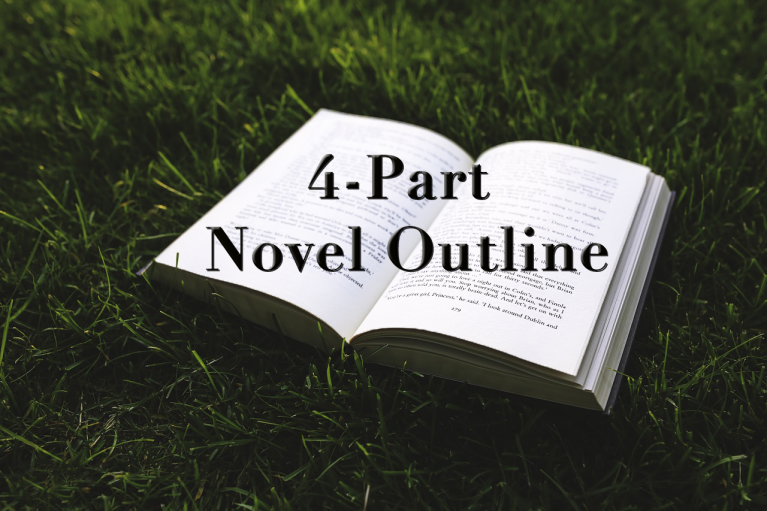I love to come up with novel ideas. Completing a novel, on the other hand, tends to be far more difficult. What always trips me up is the lack of a novel outline. I have a great idea, I think I know where I’m taking it, and then I get lost. In the past, it’s been an endlessly frustrating cycle that goes something like this:
- I have this great idea for a new story. YAY!
- Let’s get started right away. Okay, chapter 1.
- Wow, I’m impressed by how well this story is going. I’m already on chapter 4.
- Wait, something is wrong. What is my character doing? I don’t like this direction. I need to change chapter 2 completely.
- Okay, chapter 2 is done, but now chapter 1 is having issues and I have to rewrite everything from chapter 3 on. Let’s see if I can just fix chapter 1 really quick.
- Crap. None of this is working. Chapter 1 is better, but now the story is brand-spanking new. What was I thinking? I’ve wasted 50,000 words.
- I give up.
The cycle has annoyed me to no end, but I stuck with it because I didn’t believe in a novel outline. I thought that some people needed novel outlines, but I never would. My characters told my story and an outline would hamper my creativity too much and harm my writing. I was incredibly wrong. One of the most helpful blogs I ever read can be found on Storyfix.com, in particular, the ten part Story Structure Series.
What the ten part series taught me is that a novel outline doesn’t have to be crazy in depth. You just need to make sure that you understand the most important pieces of your story before you start so that you can actually write in a clear and cohesive arc. Let me break it down simply for you. Every novel is made up of four parts and eight plot points.
Novel Outline Part 1
This first section is 0-25% of your novel. The job of part one is to introduce the hero and show us what he has going on in his life. This part reveals the hero prior to the antagonist/conflict and sets the baseline for your main character. You character grows, develops, and fights back from this stage setting. This is the hook.
In your novel outline, this part should be broken down into two plot points.
-
Inciting Incident
The inciting incident occurs withing the first twenty pages of your story. This is where you establish the stakes and prepare to launch the remainder of the story. You can foreshadow events to come but right now, you’re just getting the story ready to roll.
Example: In Harry Potter, JK Rowling sets up Harry’s home life. He is a young boy of ten, who lives in a cubby under the stairs. He is treated poorly and is extremely likable and lovable. You are also introduced to the idea that he is unique because strange things happen around Harry, like glass disappearing at the zoo. The inciting incident is when Harry Potter turns eleven years old and finds out he is a Wizard.
-
First Plot Point
The first plot point in your novel outline occurs at the end of part one of your story, or approximately 25% of the way through your tale. This is the point where everything changes for your character. The protagonist enters the story and now the hero has to do something that he wasn’t doing before—react, attack, solve, speak out, love, trust, believe, etc.
Example: In HP, the first plot point is when Harry heads to Hogwarts. At this point, Harry has reached a point of no return. He has entered the world of wizards and will be sorted into houses at Hogwarts and begin his new life.
Novel Outline Part 2
The second part of a novel outline encompasses your novel from 25% – 50% of its length. This part of the book is the hero’s journey. Their response to the conflict introduced in part one. The hero in this second part of the story is just trying to survive and make it to part three.
In your novel outline, there are two plot points within this part.
-
First Pinch Point
This is where you show your reader the bad guy in all his glory. At this point, you remind the reader of what your hero is facing and how far they will have to go to overcome the bad guy.
Example: This is when Harry is sitting in Hogwarts at the Gryffindor table and gets his first look at Snape and Professor Quirrell. Harry’s scar burns for the very first time.
-
Midpoint
This is the plot point half-way through your story and the time where something big is revealed. The midpoint changes everything and gives the reader and the character a peak behind the curtain.
Example: In HP, the midpoint is when Harry realizes that the package Hagrid took out of Gringotts is what is being protected by Fluffy in the third-floor corridor.
Novel Outline Part 3
The third part of your novel outline covers 50% – 75% of your story and is where your character now begins to try and fix things and fight back. Where part one and two have seen your hero as a reactionary character, finally your hero is responding and attacking the problem and protagonist head on.
In your novel outline, there are two plot points within this part.
-
Second Pinch Point
Like the first pinch point, once again this is where you remind your reader what your hero is up against. At this time, the antagonist is much stronger and more frightening than ever. Your hero is going to have a huge hurdle to overcome after the second pinch point reveal.
Example: In HP, at the second pinch point Harry overhears and see Snape showing Filch his bleeding leg and Harry realizes that Snape tried to get past Fluffy. At this point Harry realizes that Snape will stop at nothing to get the package and Harry will have to be smarter and quicker.
-
Second Plot Point
This is the final injection of new information. After this point, all information has been shared and nothing new can enter the story. This is the final catalyst to bring about the resolution.
Example: In HP, at this time Harry learns that the package is the Sorcerer’s Stone and that it provides immortality. If Harry allows Snape to get the stone, he can bring Voldemort back. This knowledge severely ups the stakes of the story.
Novel Outline Part 4
The final piece of the novel outline closes out the story between the 75% – 100% mark. No new information enters the story during this part of the novel outline but here the hero finally faces the antagonist and leads the battle to the end.
-
Climax
This is the final battle the epic conclusion of everything you have built. This is where your hero finally faces the bad guy head on and wins or loses. Your hero has the be the main character in the climax, the one taking the lead.
Example: Harry, Ron, and Hermoine head into the third-floor corridor and each plays a role in getting to the end. Harry though is the only one to make it to the mirror and to face Voldemort alone.
-
Resolution
This is the final wrap up that closes out the story and if the book is part of a series, this is where you leave the story open for additional books.
Example: Harry faced and defeated Voldemort this time, but he is not dead and Dumbledor makes it clear that Harry’s journey is only beginning and that he’ll see him back at school next year.
Using the Novel Outline
You can use and create the novel outline however you see fit. I have found success using an excel document. It seems strange, but the ability to quickly edit cells and move information around is a lot of help. And if you need to add scenes, instead of copying and pasting everything down, you just insert a new cell and start writing. Excel keeps your novel outline organized and easy to follow.




















